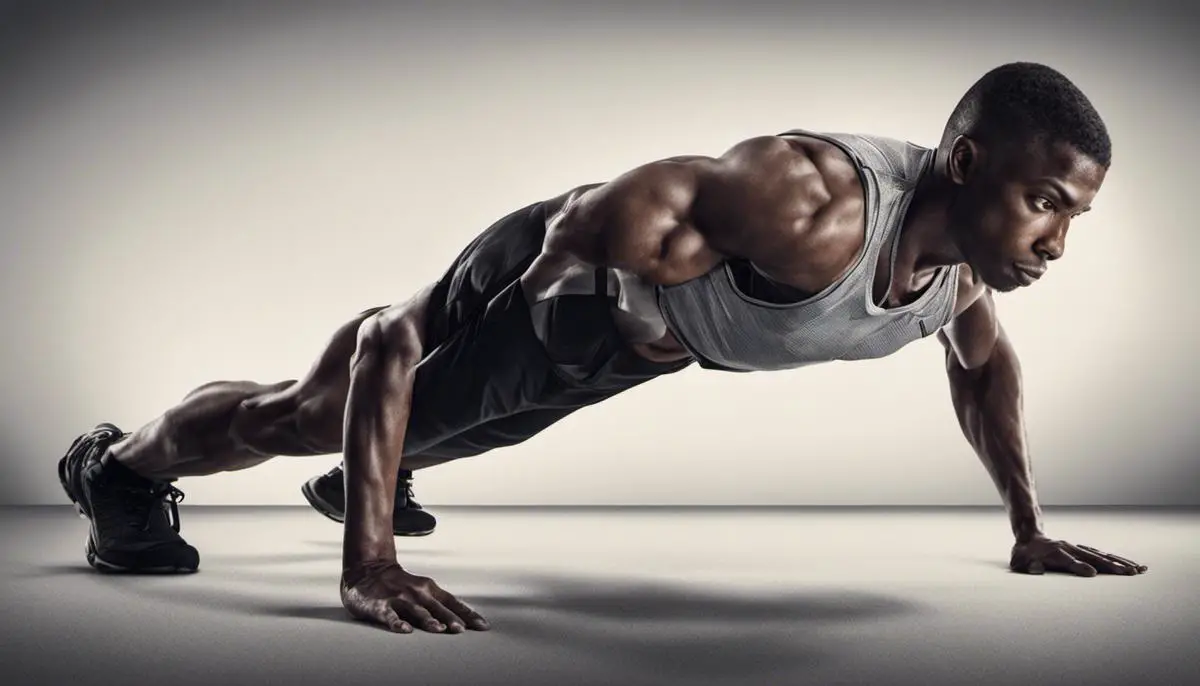Navigating the realm of exercise can be a complex pursuit. Our bodies are intricate mechanisms, full of different muscle groups that work in harmony to execute various movements. One of the most well-known yet often misunderstood exercise is the push-up, an all-encompassing workout that stimulates numerous muscle groups. In this detailed exploration, we’ll be delving into the anatomy of a push up, highlighting the various muscles that are manipulated including the pectoralis major, deltoids, rhomboids, triceps, brachialis, and abdominals. Further, we’ll provide insight into how one can transition from a full push up to a knee push up — a useful modification for beginners or those building strength — without losing the engagement of these key muscle groups. The primary objective is to foster understanding of the specific muscles involved in knee push ups and how to maximize their activation.
Anatomy of a Push Up
Push Up Power: Unleashing the Potential of the Human Body’s Prime Movers
Roll out that exercise mat and prepare to propel yourself upwards, because today, we’re embarking on a deep dive into the unsung heroes of one of the most esteemed exercises in the fitness arsenal – the humble push up. Yes indeed, more than just the pendulum of the typical gym workout, this move drives our bodies to their highest expression of strength, agility and tenacity.
It’s time to shine a deserving spotlight on those groups of muscles that fire up when you press your palms against the floor and elevate your body into the air.
Powering Up With Pectoralis Major
When you talk push-ups, the pectoralis major, located in the chest, undoubtedly emerges as the star of the show. This large muscle is primarily responsible for the pushing motion, flexing like a powerful, anchored spring each time you lower your body towards the ground, and forcefully contracting to propel you back up.
Boosting Makeover With Biceps and Triceps
As anyone who’s ever struggled to finish a set can attest, the arms take on a serious load during a push up. Bringing brawn to the shoulder and elbow joints are two muscle groups: the biceps brachii at the front of the upper arm, and the triceps brachii at the back. These phenomenally adaptive muscles tend to grow stronger, faster, ensuring you go from gut-busting to ground-breaking in record time.
Deltoideal Dexterity
Control, stability, and precision define the role of the hardworking deltoids that cap the shoulders. Working in concert with the pecs and arms, these triangular muscles ensure that the upper body moves in a cool, controlled manner.
Abdominal Allies
Never underestimate the role of the abdomen in a well-executed push up. Remember, the core is your center of gravity and maintaining it is key for both balance and movement. Enter the rectus abdominis and the transverse abdominis – their contraction keeps the body taut, protecting the spine and ensuring that the body moves as a single unit.
Rounding out the Team: Quadriceps
Finally, let’s not forget about the legs. Whilst they may seem to be just along for the ride, the quadriceps are quite the contrary. These muscles, found on the front of your thighs, function as stabilizers during the entire motion, ensuring that the body remains straight and does not sag or lift.
Now, with the real muscle MVPs of the push up firmly in your knowledge bank, it’s time to get energized, focus and enhance your workout. Remember, practice progress, dedication and consistent technique will make your push ups stronger and safer, while optimizing muscle engagement. So go ahead and power up your push-ups with newfound know-how!

Modifying Push Ups to Knee Push Ups
The Shift from Full to Knee Push-Ups: Muscular Engagement Explained
Transitioning from a full push-up to a knee push-up is often touted as a ‘scaled-down’ version of the exercise, enabling beginners to build up their strength and endurance. However, despite being a modified form, the knee push-up still engages certain muscles differently than the full push-up. Let’s dive deeper into the nuances of this transition’s effect on muscle engagement, beyond what we’ve already discussed about the Pecs, Biceps, Triceps, Delts, Abs, and Quads.
- Lower Back and Glutes: A well-executed full push-up keeps the body in a straight line from head to heels, requiring the lower back and glute muscles to work throughout the move. However, when moving onto the knees, the tension on the lower back and glutes significantly reduces as they are no longer actively engaged in maintaining a straight body line.
- The Hamstrings: In a full push-up, the hamstrings act as co-contractors with the glutes and abs, helping maintain a rigid body line. As we shift to knee push-ups, the engagement of the hamstrings diminishes. Although still involved, their role becomes lesser due to the changed position.
- The Serratus Anterior: Found along the sides of the chest, the serratus anterior plays a vital role in protracting the shoulder blades, a critical component of the push-up movement. With the transition to knee push-ups, although its engagement doesn’t disappear, it does decrease compared to a full push-up.
- Tensor Fasciae Latae (TFL): This little-known muscle, located on the outside of the hip, helps stabilize the body during full push-ups, particularly when the body is in motion. However, as we transition to knee push-ups, the TFL’s engagement drops, as the demand for stabilization is less than that of a full push-up.
Switching from a full push-up to a knee push-up isn’t merely an easier version of the same exercise, it’s a different exercise in itself. In fact, the impact on the engaged muscles changes, and some muscles are less involved. It is valuable to remember this when using knee push-ups as a step to build towards full push-ups. Remember, every form of push-up has its unique advantages and muscular demands, so let’s value each in its own way and push on!

Targeted Muscle Work in Knee Push Ups
Depth Dive into Knee Push Ups: A Seemingly Simple Exercise with Significant Impact on the Body
Pushups are an exercise staple in many fitness routines – a simple and effective activity that works your upper body and core while requiring no equipment except for your own body weight. In this article, we’re zeroing in on knee pushups, an excellent variation for beginners or for those who want to work their muscles without straining too much. We’ll be looking at some muscles that virtually underpin this exercise but didn’t receive their due in the previous coverage: the lower back, glutes, hamstrings, the Serratus Anterior, and the Tensor Fasciae Latae (TFL).
First up, let’s talk about the lower back and glutes. These two muscle groups play an essential role in maintaining your form during the knee pushups. They help to sustain your body alignment, ensuring you’re not dipping or lifting your hips. This requires constant work from these muscles, particularly as fatigue sets in.
Then we have the hamstrings. While they may seem like a non-player in a pushup, their role is more considerable than you think. The hamstring muscles help in maintaining tension in the rear chain of your body, keeping your knees off the floor throughout the exercise.
Next is the Serratus Anterior, a less familiar name in the world of workouts but equally important. This broad muscle lies along the ribs and is instrumental in the protraction of the shoulder blades – in short, it helps to stabilize the shoulder during each lowering and lifting phase of a pushup.
And finally, we touch upon the Tensor Fasciae Latae (TFL), a tiny muscle located on the outer edge of your hip. This muscle assists in maintaining your hip stability during the knee pushups, preventing the unwanted lateral movement and ensuring your body stays aligned from head to knees.
Now, on to the core question: how can we maximize the activation of these muscles during knee pushups? This comes down to a key principle – form over speed.
Starting in a tabletop position, lower yourself until your chest is an inch off the ground, ensuring your elbows stay close to your body. Visualize these muscles; engaging them consciously can help in maximizing activation. Pay attention to where your body is in space (a fancy term for this is ‘proprioception’) and adjust accordingly. Make sure not to rush your pushup – a slow and controlled descent will recruit more muscle fibers than a quick drop.
And that’s the end of our deep dive into the muscle-tastic world of knee pushups! Don’t underestimate them – these modifiable exer-heroes are worth their weight in gym gold! Keep pushing, and remember – it’s all about finesse, not speed. Happy exercising!

As we have explored, the knee push up is a versatile, accessible workout that engages several significant muscle groups, from the pectoralis major to the triceps and deltoids. With a solid understanding of the anatomy of a push up, it’s possible to adjust the exercise to one’s own fitness level while ensuring optimal muscle activation. Although starting with knee push ups, transition to a full push up as your strength increases will further amplify the benefits. Grasping how these muscles function together in the push-up motion provides a direct route to refining our workout strategies and realizing our fitness goals. Whether you’re just starting your fitness journey or looking to optimize your routine, remember that knowledge is power, and understanding these muscle groups and the actions they perform is the first step towards improvement.

